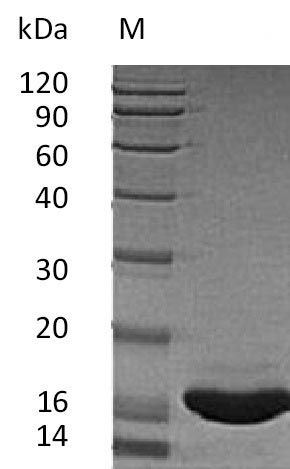Recombinant Human Kit ligand (KITLG) is produced in an E. coli expression system, covering the amino acid region 26-189. This product is tag-free and shows a purity level exceeding 95%, as verified by SDS-PAGE analysis. It demonstrates biological activity, with an effective dose (ED50) of 1-5 ng/ml, determined through a cell proliferation assay using TF-1 human erythroleukemic cells. The endotoxin level remains below 1.0 EU/µg, as measured by the LAL method.
Kit ligand (KITLG), also known as stem cell factor (SCF), appears to play a crucial role in hematopoiesis. It promotes the survival, proliferation, and differentiation of hematopoietic stem cells. The protein is involved in various signaling pathways and seems essential for the development of melanocytes, germ cells, and interstitial cells of Cajal. Researchers commonly use KITLG to study stem cell biology and related cellular processes.
Potential Applications
Note: The applications listed below are based on what we know about this protein's biological functions, published research, and experience from experts in the field. However, we haven't fully tested all of these applications ourselves yet. We'd recommend running some preliminary tests first to make sure they work for your specific research goals.
1. Cell Proliferation and Viability Assays
This recombinant KITLG is confirmed to be biologically active (ED₅₀ 1-5 ng/ml) and suitable for proliferation studies in KIT-expressing cells. However, the E. coli expression produces a non-glycosylated protein, which may exhibit different receptor binding kinetics or stability compared to native glycosylated KITLG. Researchers should validate that proliferation kinetics and dose-response relationships match those induced by mammalian-expressed KITLG in their specific cell models.
2. Hematopoietic Stem Cell Research
The protein can be used for hematopoietic stem cell studies, but the non-glycosylated form and partial sequence may not fully recapitulate native KITLG's stem cell maintenance functions. The soluble form (26-189aa) may lack membrane-anchored KITLG's specific signaling characteristics important for stem cell niches. Researchers should validate key findings with full-length, mammalian-expressed KITLG or primary stromal cell co-cultures.
3. Signal Transduction Pathway Analysis
The biologically active KITLG is appropriate for signaling studies, but the non-glycosylated form may alter signaling kinetics or amplitude in some pathways. Researchers should validate that phosphorylation events (e.g., KIT receptor, AKT, MAPK) and downstream responses match those induced by glycosylated KITLG, particularly regarding signal duration and feedback regulation.
4. Antibody Development and Validation
This KITLG serves as a good antigen, but antibodies generated against this non-glycosylated, partial sequence may not optimally recognize native, glycosylated KITLG. Comprehensive validation should include testing against mammalian-expressed, full-length KITLG to ensure recognition of physiological forms. The confirmed bioactivity supports the development of function-blocking antibodies.
5. Protein-Protein Interaction Studies
The protein is suitable for interaction studies, but the non-glycosylated state and partial sequence may affect interactions with some binding partners. Studies focusing on core KIT receptor interactions are well-supported, but interactions involving glycosylation-dependent epitopes or full-length-specific domains should be validated with native KITLG.
Final Recommendation & Action Plan
This E. coli-expressed partial human KITLG is a functional reagent with confirmed bioactivity, but researchers should account for its non-glycosylated state and partial sequence. For immediate use, employ it in the 1-10 ng/ml range based on the ED₅₀, but validate dose-response relationships in your specific cell systems. When studying hematopoietic stem cells, complementing with mammalian-expressed KITLG controls to ensure physiological relevance. For signaling studies, the protein is suitable for initial pathway mapping, but critical findings should be verified with glycosylated KITLG. When developing antibodies, this protein is adequate for generating domain-specific reagents, but validated against native KITLG for comprehensive epitope coverage. For interaction studies, focus on core KIT receptor interactions and validate novel findings with full-length protein. Always include appropriate controls and consider that different cell types may exhibit varying sensitivity to non-glycosylated versus glycosylated KITLG stimulation.






